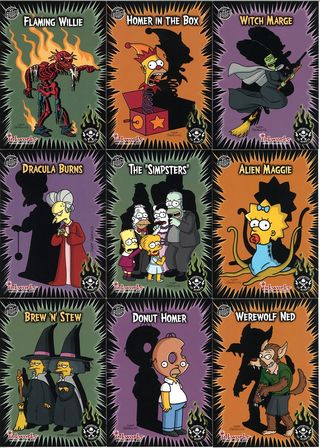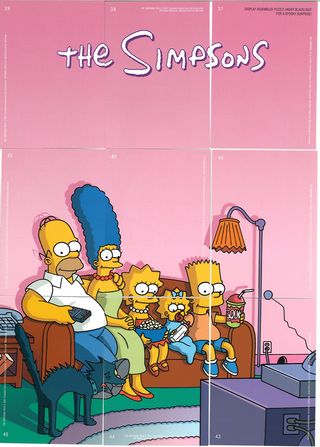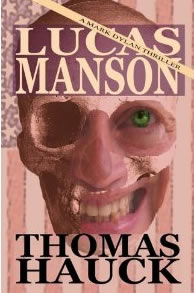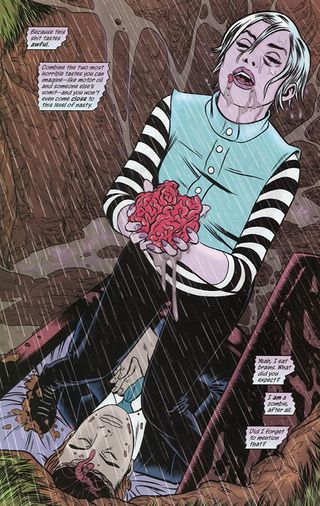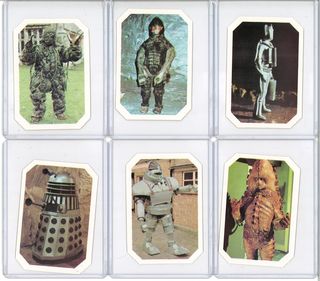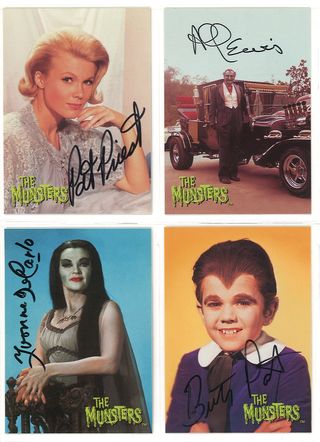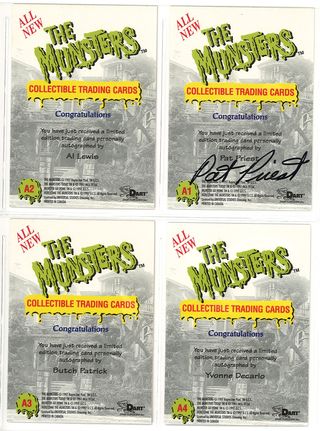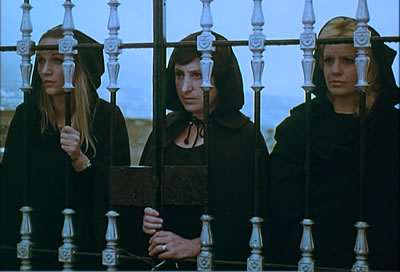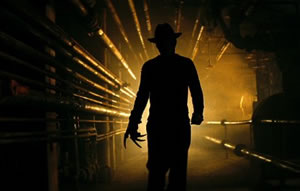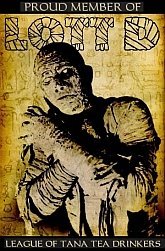From Zombos' Closet
From Zombos' Closet comes a classy and trashy collection of popular culture artifacts for those who love the terrors and treats found in movies, books, and Halloween.
May 24, 2010
Trading Cards: The Simpsons Mania Set
Treehouse of Horror
Posted at 11:30 AM in Trading Cards | Permalink | Comments (2) | TrackBack (0)
Book Review: Lucas Manson by Thomas A. Hauck
Roxy joined the conversation. "We need to work this out," she said firmly. "We've got to find a way to feed ourselves on extended tours without leaving a trail of carcasses behind us. I heard they found the ones in Detroit and Miami. Sooner or later some junior detective is going to stick some pins in a map and make the connection. Dumping these things in a harbor or a vacant lot is not going to work. Even if they happen to find one, we've got to make sure that there is nothing linking the carcasses to us."
Reading Thomas Hauck's novel Lucas Manson is like sitting in one of those taxing corporate meetings that should have died at the sixty-minute mark but still lingers on well past it; and you need to take a bio-break badly; and there's no more coffee; and somebody needs to say something that brings closure and quickly. I'm exaggerating somewhat, but I've read very few novels that force me to skim pages because of their lengthy 'corporate meeting' styled discussions blowing off the action with 'tell me' instead of more preferable 'show me' exposition; leaving me with feeling the payoff--the all important underpinning that justifies a story's events and characters--doesn't add up. There is not enough suspense written in to make it a thriller; not enough horror described to make it frightening; and worse, not much excitement to be garnered from the characters and their actions. Lucas Manson's structure is more draft-stage than print-ready.
Continue reading "Book Review: Lucas Manson by Thomas A. Hauck" »
Posted at 09:00 AM in Books (Bad) | Permalink | Comments (0) | TrackBack (0)
Tags: book review, horror, lucas manson a novel by thomas hauck, slasher
May 20, 2010
Comic Book Review: I, Zombie 1 Dead to the World
Combine the two most horrible tastes you can imagine--like motor oil and someone else's vomit--and you won't even come close to this level of nasty. Yeah, I eat brains. (Gwen in I, Zombie, Issue 1)
Zombos Says: Good
I, Zombie from Vertigo is an urban fantasy set in Eugene, Oregon, a town very much like Archie Comics' Riverdale. Instead of Jughead, Betty, and Veronica, however, the grave-digging Gwendolyn Dylan has friends like Ellie, a Go-Go Dancer ghost with a beehive hairdo, and Scott, a were-terrier boyfriend with puppy-love eyes. The gang likes to hang out at Dixie's Firehouse, the local malt shop and diner.
When not at Dixie's, Gwen digs graves at the Green Pastures Cemetery, which boasts their naturally wholesome methods of interment. Gwen's dirt-shoveling skills come in handy because she's a 20-something zombie who needs to chow down on a mass of gray cells every month to keep from turning into a less attractive and stinkier one. The catch is that when she eats a recently interred person's brain, she experiences the memories, pleasure, anguish, and desires the person left behind before shuffling off to points unknown. This time around, that shuffling off involves murder.
There's a lot of kitschy-cute weirdness crammed into this first issue: a mysterious corporation concerned about the surge in permanent residents at Green Pastures Cemetery; a former boyfriend Gwen anxiously avoids; the question of who murdered her latest dinner guest and why; and paintball vampires prowling around. Introductions are fast and brief in this ambitious issue, leaving me with anticipation for the next issue and hoping it doesn't fall flat under its own weighty cuteness. Michael Allred's artwork melds with the odd characters and their peculiar talents well enough to keep the tone balanced for the light and dark drama-kitsch writer Chris Roberson is aiming for.
DC Comics sent me a courtesy copy for this review.
Posted at 11:46 AM in Comics/Manga | Permalink | Comments (1) | TrackBack (0)
Tags: chris roberson, DC comics, i, michael allred, vertigo, zombie issue 1
Trading Cards: Doctor Who Cadbury Typhoo 1976
Posted at 10:14 AM in Trading Cards | Permalink | Comments (4) | TrackBack (0)
May 19, 2010
Book Review: Tooth and Nail By Craig DiLouie
With the zombie well beginning to run dry of ideas, it's tough to come up with new angles to build around the gut-munching simplicity of the undead. Fast or slow, young or old, there's not much you can do with them beyond their insatiable appetite for flesh and sweet meats, and the duck and cover action it usually entails. While gimmicks abound, like dressing them up in Victorian finery and serving them up with tea and crumpets, you can only go so far before even they start looking long in the tooth and come up short on the drama.
One thematic darling of the zombie fiction set is to have a pandemic erupt sending citizens and politicos, civilians and military to hell in a designer handbasket. Usually blamed on terrorists or a military experiment gone horribly wrong, this virus hits the population hard and takes down everyone in its path. Queue the final curtain and much wailing and gnashing of teeth (on both living and dead sides of course).
In Tooth and Nail, Craig DiLouie follows the soldiers through the hell they must travel when New York City becomes a massive killing zone. His virus is the Hong Kong Lyssa, a variation that mutates into something more like a parasite than simply a nasty bug. His Mad Dogs-- what the people infected with the virus are called--act very much like extras from 28 Days Later, but in his claustrophobic urban battleground, with no Starbucks, Dunkin' Donuts, or even a 7-Eleven open to grab a coffee break and Twinkie, the platoons sent to protect the
population wind up needing protection from that population even more. This sets up the intriguing emotional, spiritual, and intellectual conflicts inherent in such a situation: how can the military fulfill its primary objective to protect a population that is devolving more and more, by the minute, into an enemy. It's a unique premise. DiLouie, unfortunately, does little with it.
The last book I read that handled present tense well was David Moody's Hater, which was also written from the 'questionable perspective' of the narrator. DiLouie writes Tooth and Nail in the present tense, but his stream of action from characters to places to thoughts becomes awkward and intrusive at times, and twice shifts unexpectedly into a first person narrative, leaving me wondering who's speaking. Piling on military jargon and dividing chapters between the various platoons, the scientists at the medical facility researching a cure, and the Tilden Middle School campaign gone sour, it's a hard go to remember which platoon was involved with what mission and where they were or were headed. I eventually lost track of which soldiers went with which platoon halfway into the story. The scientists were easier to follow because they were written with two-dimensional dialog and B-movie scientist-type temperaments.
DiLouie provides a list in the front of the novel that spells out the military abbreviations used; AG stands for "assistant gunner," and FPF is "final protective fire." But after paging back and forth a few times to find out what each abbreviation meant, I felt like I was back in college doing a term paper. I bet you don't know what SINCGAR* stands for? An odd use of brief subtitles for chapters and transitions within those chapters sticks out like a sore thumb in the reader's eye, either telegraphing key upcoming moments or jarring his narrative flow. They reminded me of those melodramatic blurbs on the Mars Attacks! trading cards, just not as effectively used here.
At the crux of the story are the soldiers and their mental anguish over dealing with Mad Dogs, potential Mad Dogs, and ignoring pleas for help from desperate New Yorkers while trying to stay alive. Their growing consternation, helplessness, and resignation to the inevitable breakdown in command center communications and conflicting goals leaves them spiritually and mentally handicapped, unable to cope with a rising death rate and their lowering prospects for success. DiLouie almost succeeds in capturing this roller coaster of potential drama, but sacrifices the fast turns and sudden dips for repetitive action sequences involving platoons making their way to somewhere because of seemingly random orders, through streets filled with hordes of Mad Dogs. At times these sequences are engaging for us as much as the soldiers--DiLouie works hard to incorporate realistic military strategy into these battles--but in-between them the rest of the story lags behind, filled with good-soldier-does-his-duty-to-the-end-no-matter-what flippancy.
The virus itself transforms into a parasite well into the novel, although this sudden change in its propagation characteristics gives the impression DiLouie only thought of making it a parasite well into the novel. With no foreshadowing, the revelation carries little dramatic impact when it appears and fails to provide much dramatic direction afterwards (read The Andromeda Strain and you will understand what I mean). His scientists are too busy doing B-movie duck and cover gyrations when their medical facility is compromised to appreciate the twist, leaving only one of them to convey the sudden discovery to a disintegrating military establishment.
In one promising plot thread that DiLouie brings up, but annoyingly leaves dangling, a soldier goes AWOL after a pretty college girl entices him to help her. What he eventually finds is a bunch of college kids who want to steal his weapons so they can hop over to New Jersey with a better chance of survival. They even ask the soldier to join them, reasoning he's the best one to handle the fire power. He bluntly says no, they leave with his guns, and this fetching storyline dies as quickly as it began.
I can't help but wonder how the college kids made out.
*SINCGAR: single-channel ground and airborne radio system
A digital copy of Tooth and Nail was provided for this review.
Posted at 04:17 PM in Books (Bad) | Permalink | Comments (0) | TrackBack (0)
Tags: craig dilouie, tooth and nail novel review, zombie fiction
Trading Cards: The Munsters Autograph Cards
How much longer till Halloween? Here are the Dart Flipcards, Inc. The Munsters autographed trading cards for your Munsterish delight.
I met the adorable Pat Priest at one of the Drunken Severed Head's invitation-only parties, held during a Monster Bash convention. She regaled us with funny stories of her work on The Munsters set, how she turned down a free car from Elvis, and how she threw away the show's scripts and other future hot collectibles when no longer needed. Memorabilia was not a hot topic in those days apparently. I ate at Al Lewis' restaurant called, fittingly enough, Grampa's in Greenwich Village back in 1987. I didn't notice the place until this guy sitting in front yelled "Are you hungry?" and held the door open for us, inviting us in. It was Al Lewis, chomping on a big cigar and having a ball. The Italian food was awesome, too.
Posted at 11:47 AM in Trading Cards | Permalink | Comments (0) | TrackBack (0)
Tags: al lewis, eddie, grandpa, lily, marilyn, munsters dart autograph cards, series 1, trading cards
May 18, 2010
Movie Review: Godspeed (2009)
In Search of Intensity
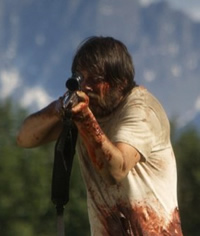 A small picture vibrating with grand passions, “Godspeed” transforms the vast lawlessness of the Alaskan wilderness into a playground for damaged souls and Old Testament mischief. Jeannette Catsoulis, New York Times)
A small picture vibrating with grand passions, “Godspeed” transforms the vast lawlessness of the Alaskan wilderness into a playground for damaged souls and Old Testament mischief. Jeannette Catsoulis, New York Times)
Once again, Ms. Catsoulis' review is perplexing to me. Interesting, but very perplexing. (Zombos)
ZC Rating 2 of 7: Fair
Twice I started watching Robert Saitzyk's thriller Godspeed and twice I stopped at the same scene in the movie. I wondered why. It's when faith healer Charlie Shepard (Joseph McKelheer) and Sarah Roberts (Courtney Halverson) have awkwardly met and each wants the other to go in a different direction, which is either to find something or to lose something, or maybe both. Intensity should be radiating from them but it doesn't and I couldn't pin down why. Maybe it's Saitzyk's direction, which lingers too long on scenes, trying to give them importance the story and its characters can't muster, or maybe it's McKelheer's struggle (he co-wrote with Saitzyk and Knauf) with overly contemplative dialog inadequate for fully expressing his struggle with his inner demons. There's a weightiness to Godspeed that doesn't add up given its story, and for a thriller--I wouldn't call Godspeed a horror movie--it never finds the intensity it needs to involve us, or justify its artsy spiritual despair spilling over into bloodshed at the beginning and the ending of the movie.
Given the beautiful but lonely vista of the Alaskan location, Saitzyk doesn't allow his tormentors or their tormented much interaction through metaphor or religious iconography with the wilderness surrounding them--and in them; instead, he fills the empty spaces with drawn out, self-conscious talkiness, where everyone moves hopelessly around a lot pontificating on their desires and sins without making us feel they're sharing the burden with us. Neither are their actions embellished or even made insignificant by God's intrusive knack with nature all around them. This leaves the movie's underwhelming religious-poking bland to watch, forcing more of our attention on a weak story just not engrossing enough to hold it, which, given the soul-searching and ulterior motives abounding at its heart it should. Godspeed doesn't let us feel the philosophical ardor it so heavily tries to concern us with.
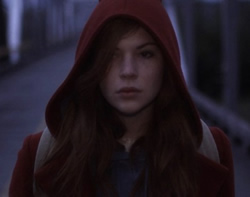 While Shepard's family is tastefully being killed, seen between glimpses of the serene aurora borealis lights and his tryst with a prostitute, the emotional impact of the murders falls flat. Moving too slowly, back and forth, between the lights, the murders, and the prostitute's consternation over his need for her when he has a beautiful wife at home, Saitzyk's monkish pacing dulls the intrinsic horror and, worse, fails to build momentum beyond Shepard's retreat into the wilderness.
While Shepard's family is tastefully being killed, seen between glimpses of the serene aurora borealis lights and his tryst with a prostitute, the emotional impact of the murders falls flat. Moving too slowly, back and forth, between the lights, the murders, and the prostitute's consternation over his need for her when he has a beautiful wife at home, Saitzyk's monkish pacing dulls the intrinsic horror and, worse, fails to build momentum beyond Shepard's retreat into the wilderness.
We see him months later, all Grizzly Adams and living in a trailer home, when Sheriff Mitch (Ed Lauter) pays a visit to apprise him that nothing has been discovered concerning his family's murder. Mitch asks about his questionable past, the one that brought him to the small town. Saitzyk and McKelheer beat this scene to death while Mitch waits for Shepard to vent his frustration and anger. And vent it some more. At the local diner, Sarah finds him blocking out lines in his Bible with a Magic Marker. When she ventures closer, he explains what he's doing: he's blocking out the lies of God. Sarah needs him to return home with her so he can save her brother Luke (Cory Knauf) from himself. Luke hates Shepard. Luke wants to start his own little world of salvation for his followers. Too much time is spent listening to Luke preach to his followers and showing closeups of their faces as they intently pay attention.
Exactly what Shepard is retreating from is not fully explained. It's possible he really does have a gift buried in him for faith healing; but it's also possible he's a charlatan who really does want to heal the sick. Maybe he's a bit of both: a faith healer who's lost his gift for healing and wonders why God has forsaken him. Does he blame himself? Does he blame God? His inner turmoil starts well before his wife and child are murdered, and his inability to heal has leached out to overwhelm Sarah and her brother.
The both of them are in a soul-searching freefall after the death of someone close and important to them. Both blame Shepard, but for different reasons. Sarah is drawn to him both romantically and spiritually. Luke is drawn to him but with a different reason. All three suffer from their inner demons, but given all of this inevitable tension from unfulfilled love, seething hatred, and constant religious questing, the monotone direction keeps it corked, the superficial story keeps it bottled up, and the acting keeps it on the shelf, never threatening to become more than something interesting to look at but not to partake in.
Posted at 05:04 PM in Movies (Indie) | Permalink | Comments (2) | TrackBack (0)
Tags: drama, godspeed movie review 2009, horror, thriller
May 14, 2010
LOTT D: Remembers Video Store Horror
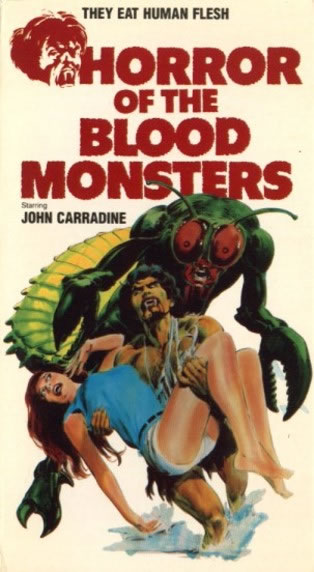 The members of LOTT D remember when horror came in a VHS box, all lurid and gamy, just waiting to be eagerly plucked from the local video store's shelves like a ravenous zombie ripping out a fresh, red-dripping, still-beating heart from a cracked rib-cage. Often promising more than they would deliver, and sometimes delivering more than they dared promised, their rectangular sleeve covers beguiled us with garish text and images so outrageous and impertinent, we couldn't resist the temptation. We cherish them. And we cherish the stores that gave us this world to explore: all the nightmares, all the terrors, and all the fun that crammed those shelves, waiting to be taken home.
The members of LOTT D remember when horror came in a VHS box, all lurid and gamy, just waiting to be eagerly plucked from the local video store's shelves like a ravenous zombie ripping out a fresh, red-dripping, still-beating heart from a cracked rib-cage. Often promising more than they would deliver, and sometimes delivering more than they dared promised, their rectangular sleeve covers beguiled us with garish text and images so outrageous and impertinent, we couldn't resist the temptation. We cherish them. And we cherish the stores that gave us this world to explore: all the nightmares, all the terrors, and all the fun that crammed those shelves, waiting to be taken home.
Yes, we remember.
Dr. Gangrene remembers the sweet horrors delivered by mom and pop video stores: I tell you what I miss… I miss mom and pop video stores. They are all too quickly becoming a thing of the past...
Lost Highway does a last rewind for Video Vault: Well, yesterday I learned about one business closing, a cult video store named “Video Vault” that really hit close to home for all of us here at Lost Highway...
Dinner With Max Jenke got it all on video: watching these stores and the VHS format vanish from the face of the earth in the wake of DVDs and Netflix makes me feel like my past is in the process of being gobbled up by those hell-spawned Pac-Man things from Stephen King’s The Langoliers...
Cinema Suicide reflects on the boss box art for really bad movies: Video box art became the stuff of legend and lured a lot of people into renting some obnoxious crap based entirely on cool pictures...
Cinema Fromage fondly remembers the Video Place: As we walked into the Video Place, the first thing to hit you was the smell. A peculiar smell indeed, however not necessarily foul. My foggy recollection seems to think it was a mixture of particle board, must, and popcorn...
Posted at 09:00 AM in LOTT D | Permalink | Comments (0) | TrackBack (0)
Tags: lott d remembers video store horror, VHS
May 11, 2010
Movie Review: Necrophagus (1971)
A Strange Case of Dereliction
"If any of you want to accompany me to the cemetery
you better get ready. I'd like to know who died."
Zombos Says: Poor
Ripped from the case files of the League of Reluctant Reviewers comes this bizarre interpretation of a horror movie. It is incomprehensible. It is Spanish. It is nonsensical. It is so bad it is as much fun to watch as to belittle. It is Necrophagus, aka Graveyard of Horror, aka The Butcher of Binbrook.
Since the direction is amateurish, the acting wooden and the script confused, one can only conclude that it was Nieva's Eastmancolor cinematography that won the film first prize at the 1971 Festival of the Cine de Terror at Sitges. (The Overlook Film Encyclopedia: Horror)
"Your hand is shaking Mr. Bolton," observed Chalmers as he ushered me into the familiar room.
He was right.
The weather had turned wetter, chillier, and foggier than was usual for May. That was my excuse anyway. My hand started shaking during the long walk to 999 Transient Street, the club where the League of Reluctant Reviewers hung out. I only come here when Zombos and Iloz Zoc do not want to bother themselves with reviewing certain movies. You know, the difficult ones. The movies normal people feel ashamed to be caught dead watching. Those guys act like critic-wimps sometimes, especially when Paul Hollstenwall is involved.
Man, that guy savors dreck like bears lick honey.
I have taken this trip often enough thanks to Paul, but it is rare for my hand to start shaking. The hand that holds the DVD. It was shaking badly now; almost as bad as when I had brought The Human Centipede to the club the other night. But that's another story. A real wild one. I must still be shell-shocked from that escapade.
"Perhaps I should take your wet coat and that DVD," he suggested. He shook the drops off my coat while gingerly easing the DVD from my clenched fingers.
I usually bring the DVD to the Champagne Room myself, but this time I let Chalmers do it. He led the way. The owner of the club, the unseen man with chalk white hands and a voice as smooth as velvet, sitting in the Chippendale wing chair always facing the fireplace, welcomed me in.
"And what have we tonight?" he asked, reaching out from the chair. "Hopefully, nothing as, shall we say, challenging as that previous movie?" He chuckled, but a little nervously.
Chalmers gave the DVD to him. Both hand and DVD withdrew behind the chair.
"Ah, I see. This should not take too long at all, I think." A white hand reached out to ring the bell sitting on the small table by the chair while Chalmers escorted me to the small waiting room, where a comfortable settee and comforting drink awaited me. This time Chalmers chose a warm Tom and Jerry instead of the usual chilled sherry. Good man.
I closed my eyes and let the hot liquid dribble down my throat, and waited for the League of Reluctant Reviewers to once again do their review magic.
A mad scientist, somewhat dead and feeding off corpse liquors to stay that way; a gaggle of women prone to hysterics and fits of slapping each other; and a skulking cemetery keeper, Mr. Fowles (Victor Israel), who gives googly-eye stares and never changes his clothes, infuse Necrophagus with unintentionally humorous melodramatics topped off by an inane story so incoherently told you will need to search Google for understanding it before you see it.
Even more surprising, you can't blame Jess Franco or Paul Naschy for this one.
The short of it has handsome Lord Sherrington (Bill Curran) return to his family castle in Scotland (actually shot in Spain) to find out what happened to his wife Elizabeth, who died in childbirth. Sherrington's brother, a research scientist (or something like that) also happens to be missing. A lengthy narration at the end of the movie explains what his brother was doing and why he went missing, but at this point, for anyone still watching, it comes too late and doesn't explain much anyway.
The long of it has two doctors acting rudely and mysteriously; Elizabeth's frisky sisters and a niece (sorry, no nudity) either pining away for or fainting over Sherrington's affections; the cemetery keeper skulking around a lot with his annoying pop-eye stare; Sherrington's fondness for playing a tune—which sounds very much like On Top of Old Smokey—repeatedly on his harmonica.
Yes, a harmonica.
Add a police inspector investigating the brother's disappearance (at least that's one possibility for the policeman’s loitering around the castle since no reason is ever mentioned), two Scream-like robed and masked attackers loitering around the cemetery day and night, and another doctor who must be a villain because each time he enters a room, the camera zooms in on his face while zither-like zing-zing-zing musical notes alert us to his potentially villainous role.
There’s also a fast change of seasons with snowball fights and summer-like greenery mixing together within a time period not more than a week or so long by my reckoning, so that’s fairly confusing, too.
When Lord Sherrington insists on playing his harmonica and seeing his wife's body, he's rebuffed by the doctors and the cemetery keeper. Entering the cemetery at night, he starts flinging dirt at the camera—pretty funny, really—as he digs up his wife's coffin to find it empty. More dirt is flung at the camera as he digs up other coffins, also finding them empty. The two robed and masked loiterers knock him out cold and drag him someplace where a pulsing mound of dirt has tubes running out of it. He wakes up. Something in the mound of dirt wakes up. He screams a lot and that's all we see: him screaming a lot.
Director Miguel Madrid's penchant for close-up monster point of view angles, showing people on the ground screaming and holding up their hands to fend off an attack from the unseen growling something, don't do much to raise the scares. Needless to say, Sherrington goes missing; but not his harmonica, unfortunately.
Endless scenes with the gaggle of women reminiscing over their lust for him (or perhaps it was his lusty harmonica playing?), berating each other for their lustful reminiscences, or holding hands and looking scared as they go searching for him in the Scottish castle that's not in Scotland, round out the rest of the 80 minutes or so running time. As well as close-ups of a gloved hand poked into an overcoat's pocket, moving from room to room, legs walking, and startled faces, punctuated now and then by the first few notes of On Top of Old Smokey or zing-zing-zing music for dramatic effect to complete the tour de force of cinematography on display here.
I’m being sarcastic.
When the monster finally does show up it goes after a girl so it can pointlessly carry her unconscious body in its arms while walking into a hail of police-fired bullets. Scratch one monster posthaste.
Devout fans of early 1970s Spanish horror movies will argue Miguel Madrid brilliantly and intentionally fragmented Necrophagus by shooting it non-linearly and then raggedly cutting his scenes to create disorientation in the viewer.
Don't believe them.
Posted at 08:13 PM in Movies (Bad) | Permalink | Comments (3) | TrackBack (0)
Tags: 1971, bad horror movie, graveyard of horror movie review, necrophagus
Trading Cards: Midnight Madness, The Surgeon
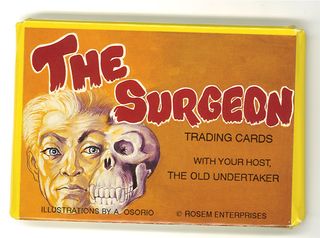 Here is the twelve card story for the series, The Surgeon, from Rosem's
Midnight Madness Card Set. Story is by Steve Kiviat, and
illustrations by Alfredo Osorio. (Copyright 1990 by Rosem Enterprises.)
Here is the twelve card story for the series, The Surgeon, from Rosem's
Midnight Madness Card Set. Story is by Steve Kiviat, and
illustrations by Alfredo Osorio. (Copyright 1990 by Rosem Enterprises.)
His patients have more to complain about than their medical coverage.
(Previously: Shroud of the Undead, Jungle Parasite, The Pharaoh's Revenge, Desert Rats)
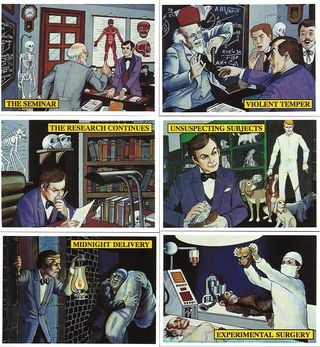
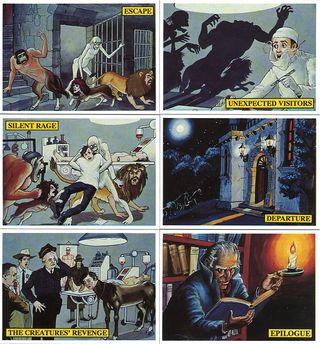
Continue reading "Trading Cards: Midnight Madness, The Surgeon" »
Posted at 10:21 AM in Trading Cards | Permalink | Comments (0) | TrackBack (0)
May 05, 2010
Movie Review: A Nightmare on Elm Street (2010)
Not a Dreamy Remake
Look, here's the thing in a nutshell: if you're going to do a remake, reimagining, reboot, or whatever you'd like to call it, you better come to the table ready to ante up big and play it for all it's worth. Otherwise, why bother?
Freddy Krueger may be properly dressed in his signature striped sweater, brown Fedora, and nasty blade glove, but he has nowhere to go in this unimaginative reimagining of Wes Craven's original nightmare. Under a deathmask's worth of immobilizing rubber makeup (although I admit it appears more medically correct), Jackie Earle Haley's perpetually pouting face made me pine for Robert Englund's glistening bald pate, leering, spongy flesh-burned face, and his manic, gleefully malicious dream-devil-in-the-boiler-room enthusiasm.
The outrageous, lethally-twisted dream intrusions that are the hallmark of this franchise are put to bed in Samuel Bayer's cardboard standee version of Freddy, where winking consciousness between Elm Street's dreamland and wakefulness is less important than an almost back to back line-up of dead-teenager-walking kill-fests, escalating the body count while decreasing emotional involvement from us for those being stalked. This is a painting by numbers, pretty to look at (it’s well photographed by Jeff Cutter), but rote in its execution of mayhem: there is no sizzle when we should feel the burn as much as child-molester Fred Krueger did.
Ironically, the interpersonal perquisites of cell phone, too many close-ups of Google-like search engine queries, and a victim's anguished YouTube-delivered solilocam cry for help, distance Freddy's victims from each other—and from us—by substituting the more intimate sleep-over vigil shown in the original film, when Tina, Nancy, and Glen fret over their shared nightmares, with a modern digital one that trades the popcorn closeness for laptops and no-doze medications. While Freddy's potential victims share a forgotten connection from having attended the same preschool, their relationships are made weaker because of this digitized distancing, rendering them less supportive of each other and easier prey for their tormentor. Which is good for Freddy because, being less creative in his attacks in this remake, he doesn't do much beyond making sparks when he scrapes his blades against the pipes.
Again and again and again.
At least Nancy remains his favorite little girl. But this Nancy (Rooney Mara) is not 1984's Nancy (played by the feisty Heather Langenkamp). Here she puts up a less-spirited fight against Freddy and spends more time searching the Internet for information and sketching her nightmares instead of trying to save her friends. Where Craven drove his story through the battle of wills between Nancy and Freddy, escalating the stakes through an ambitious series of special effects to add urgency and nightmarish uncertainty, writers Strick and Heisserer use the slow revelation of Freddy's nastiness with children as their primary driver, eschewing the giddily insane, booby-trapped confrontation between Nancy and Freddy for repetitive, almost static, boiler room scenes of Freddy looking ominous and victims looking scared. Fans can debate the merits or demerits of this changed dynamic, but this remake’s less dreamland, more rational approach keeps the story as rigid as Haley's burn makeup.
As a fan of horror movies, and yes, the original A Nightmare on Elm Street, I can tell you this movie is a disappointment because it takes from the original storyline but doesn't seem to understand it. Freddy is here, his victims are here, lots more technology use—and no weird-looking hairdos—are here, but the nightmarish invasion of one's dreams is missing; the menace that sparked the first entry in this franchise is missing; 1984's spirit behind the envelope-pushing special effects is missing.
This is one boring movie when it should have sizzled.
Now, if they had Johnny Depp play Freddy instead…?
Posted at 02:28 PM in Movies (Bad) | Permalink | Comments (9) | TrackBack (0)
Tags: a nightmare on elm street 2010 movie review, horror
April 30, 2010
LOTT D: Picks on Freddy
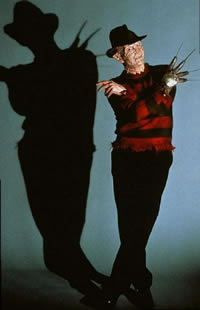 Talk about nightmares! The members of the League of Tana Tea Drinkers gang up on good ol' classic Freddy and give him the business. Elm Street will never be the same.
Talk about nightmares! The members of the League of Tana Tea Drinkers gang up on good ol' classic Freddy and give him the business. Elm Street will never be the same.
Day of the Woman gossips about the Women of Freddy: Whether it's a woman who knows exactly how to stop him, the victim he can't seem to catch hold of, or even his daughter, Freddy Krueger just doesn't have the best luck when it comes to girls.
Freddy In Space remembers the people who made Freddy so memorable (and frightful): Let's take a moment to remember those Elm Street residents who are no longer with us - but who will live on forever through the magic of film.
Vault of Horror joins in to discuss Freddy's unforgettable franchise of fear: Just in time for the much-anticipated Platinum Dunes remake of A Nightmare on Elm Street, Count Vardulon and The Divemistress, and Vault of Horror take an in-depth look at the NOES franchise. And VOH goes even further by presenting a quarter-century of Freddy goodness, too!
Evil On Two Legs gives us their top 10 pointless and irrelevant observations corey made while rewatching a nightmare on elm street earlier this week: at number 2, throughout the entire movie, heather langenkamp has a distracting pimple on her forehead.
The Lightning Bug's Lair shares the shining moment when Freddy encounters the Dream Warriors: Nightmare III plays out more like a direct sequel to the first. Well, except this time Freddy’s got jokes, and boy, does he ever have jokes.
Moon Is a Dead World speculates on the quality of the Freddy remake: I've come to the conclusion that, if written properly, this speculation may be able to give a complete, factual representation of what we might expect from A Nightmare on Elm Street.
Lost Highway detours around Freddy as the Dream Master: In this made for MTV style movie nothing is going to stop Freddy from taking out the remaining survivors from the previous Nightmare sequels.
Reflections on Film and TV discovers the Tao of Freddy: In William Schoell and James Spencer's superlative companion, The Nightmare Never Ends: The Official History of Freddy Krueger and the Nightmare on Elm Street Films, director and horror icon Wes Craven briefly recounts the youthful experience that led him to create cinematic dream-killer Freddy Krueger.
There, that should help keep you up tonight. If not, sweet dreams! Don't let the Freddy bugs bite.
Posted at 11:41 AM in LOTT D | Permalink | Comments (0) | TrackBack (0)
Tags: horror, lott d picks on freddy and nightmare on elm street, movie review
Subscribe to Weekly Email for New Posts!
Go To...
Read My Book on Kindle
I Like to Talk
Categories
- Art/Animation (32)
- Authors (28)
- Azteca/Mexican Lobby Cards (779)
- Bloggers (48)
- Books (Bad) (2)
- Books (Fiction) (51)
- Books (Graphic) (33)
- Books (Non-fiction) (31)
- Comics/Manga (85)
- Convention/Event Programs (8)
- Death (13)
- Documentaries (11)
- Freaks/Geeks (5)
- Gift Ideas (12)
- Halloween (Memories) (54)
- Halloween Candy (36)
- Halloween Costume (70)
- Halloween Light-Ups (16)
- Halloween Novelty (91)
- Halloween Paper (63)
- Haunt Attractions (8)
- Horror Hosts (29)
- Kinema Archives (51)
- LOTT D (66)
- Magazine Morgue (261)
- Model Kits/Figures (10)
- Monster Laffs (10)
- Movies (Bad) (49)
- Movies (Drive-in) (31)
- Movies (Ghostly) (19)
- Movies (Gore) (9)
- Movies (Horror) (90)
- Movies (Indie) (33)
- Movies (Non-horror) (9)
- Movies (Slasher) (12)
- Music/Radio (13)
- Pictures (102)
- Pressbooks (Horror, Sci Fi, Fantasy) (666)
- Pressbooks (Non-Horror) (198)
- Reflections (58)
- Short Stories (2)
- Superheroes (9)
- Toys/Games (23)
- Trading Cards (16)
- TV/PC (28)
- Universal Monsters (21)
- Vintage Days (26)
- Wild West Weird (6)
- Zoc's Desk (9)
Significant Others
Other Others
Copyright Notice

From Zombos' Closet by John Michael Cozzoli is licensed under a Creative Commons Attribution-NonCommercial-NoDerivatives 4.0 International License.
Based on a work at http://www.zomboscloset.com.- Copyright© 2006-2023
From Zombos' Closet's fictional characters and personal blog posts are created and copyrighted by JM Cozzoli. Additional content is copyrighted by the respective contributors and owners of that content. From Zombos' Closet is a non-commercial site for the enjoyment of fans of the fantastique, the horrifying, the trashy, and the sublime.
